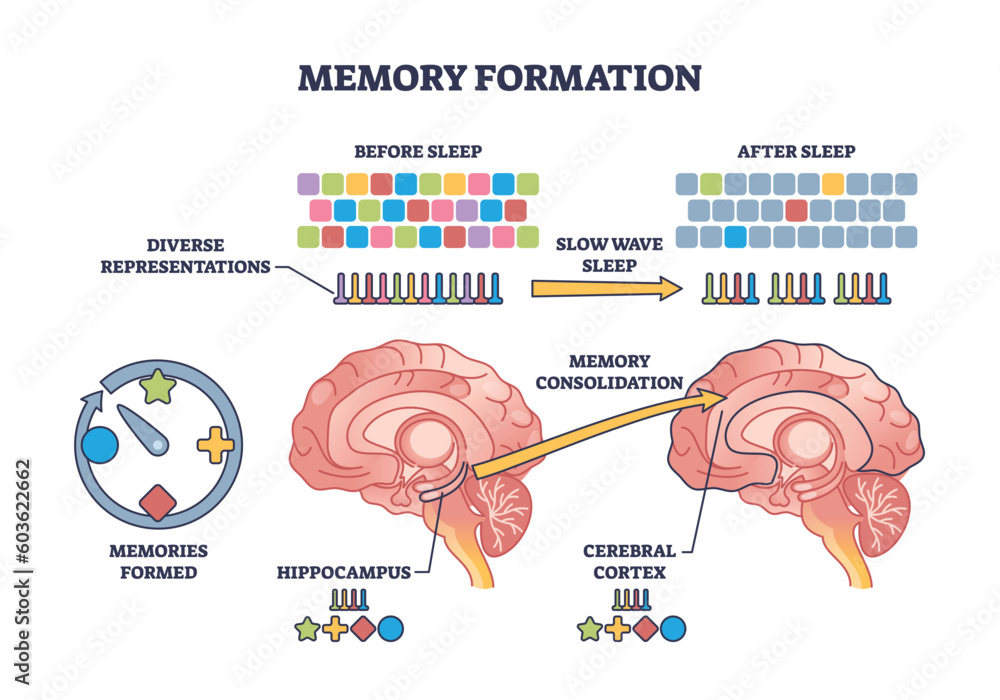Memory formation is a fascinating process intricately linked to the brain’s neuronal connections, where synaptic plasticity plays a crucial role. Harvard researchers have recently introduced an innovative technique that maps the molecular basis of how memories are created and retained, shedding light on the learning mechanisms underlying cognitive function. This groundbreaking research holds promise for enhancing our understanding of neurological disorders like dementia, where memory impairment is a significant concern. By focusing on synaptic behavior and utilizing advanced imaging methods, scientists can visualize the processes that solidify our memories — from cherished childhood moments to everyday experiences. As we explore these cutting-edge insights, the potential for developing new therapies in dementia research becomes increasingly tangible.
The concept of memory encoding encompasses various cognitive processes that govern how we assimilate and recall information. Researchers at Harvard have managed to pioneer a method that illuminates the complex networks within our brains, essential for understanding how we develop and preserve memories. This innovative approach not only highlights the significance of synaptic transmission but also provides critical insights into the mechanisms influencing learning capabilities. Furthermore, the intricate mapping of these neuronal pathways is vital for advancing our knowledge in dementia studies, which aim to revisit how synaptic adjustments relate to memory retention. By delving deeper into the dynamics of brain connections, we can venture closer to discovering therapeutic approaches that address memory-related challenges.
Understanding Memory Formation in the Brain
Memory formation is a complex process intricately linked to how neurons communicate in the brain. It involves changes in the strength and number of connections, also known as synaptic plasticity. Every time we learn something new or recall a memory, our brain undergoes significant modifications in these neuronal connections, with synaptic alterations reflecting the nature of the information processed. Notably, the research conducted by Harvard scientists has shed light on these dynamic changes, highlighting that memory resides within a dense network of billions of neurons that continually adapt, enabling us to learn and grow throughout our lives.
The groundbreaking technique introduced by the researchers, Extracellular Protein Surface Labeling in Neurons (EPSILON), focuses on visualizing synaptic behavior at microscopic levels that were previously unattainable. By mapping the proteins essential for synaptic transmission, they have unearthed new insights into how memories are encoded and retrieved in the brain. This enhances our understanding of learning mechanisms, revealing the complexity of how memories are formed and retained through synaptic strengthening or weakening, fundamental processes influenced by molecular and biochemical pathways.
Frequently Asked Questions
How does memory formation relate to synaptic plasticity?
Memory formation relies heavily on synaptic plasticity, which is the process by which synaptic connections between neurons strengthen or weaken over time. This adaptability is crucial for learning and retaining information, as it allows the brain to reorganize its neuronal connections based on new experiences.
What role do neuronal connections play in memory formation?
Neuronal connections, or synapses, are the fundamental structures through which memories are formed. Each memory is encoded in the intricate web of connections between billions of neurons. The stability and modulation of these connections, facilitated by synaptic plasticity, enable us to learn and recall information.
Can brain mapping techniques enhance our understanding of memory formation?
Yes, brain mapping techniques allow researchers to visualize and analyze the molecular mechanisms underlying memory formation. By observing synaptic behavior and the movement of key proteins involved in synaptic plasticity, scientists can gain insights into how memories are encoded and retrieved.
How does the EPSILON technique contribute to our knowledge of memory formation?
The EPSILON technique provides unprecedented detail in mapping the proteins that facilitate synaptic transmission, key to memory formation. By using advanced microscopy methods to observe these proteins in action, researchers can better understand the dynamics of synaptic plasticity and how memories are established in the brain.
What implications does dementia research have for understanding memory formation?
Dementia research is crucial for understanding memory formation since disorders like Alzheimer’s are characterized by synaptic dysfunction, leading to significant memory impairment. Insights gained from studying memory formation can help develop new therapies aimed at treating or preventing these cognitive declines.
How do AMPARs contribute to synaptic plasticity in memory formation?
AMPARs, or AMPA receptors, are vital for synaptic plasticity as they mediate the transmission of signals across synapses. Their movement and activity influence how synaptic connections strengthen or weaken, directly affecting the processes involved in memory formation and retention.
What are the benefits of studying memory formation through advanced microscopy?
Studying memory formation through advanced microscopy offers high-resolution insights into synaptic interactions. This clarity helps researchers understand how synaptic changes correlate with memory encoding and retrieval, thus paving the way for potential therapeutic strategies for cognitive disorders.
In what ways can understanding memory formation inform therapeutic strategies for neurological disorders?
By exploring the mechanisms of memory formation and the underlying synaptic processes, researchers can identify new targets for therapeutic intervention. Insights gained may lead to innovative treatments aimed at enhancing synaptic health, potentially alleviating symptoms of neurological disorders such as dementia.
| Key Points | Details |
|---|---|
| Groundbreaking Technique | The EPSILON method allows detailed mapping of how learning and memories are formed. |
| Key Proteins | AMPARs are critical for synaptic plasticity and play a major role in memory formation. |
| Research Implications | Insights may lead to new therapies for neurological disorders like dementia. |
| Innovative Observation | EPSILON enables monitoring of synaptic behavior with unprecedented resolution. |
| Future Applications | Technique may help explore various cognitive phenomena related to memory. |
Summary
Memory formation is a complex process that involves the intricate networking of neurons and synapses in the brain. The groundbreaking research highlighted the new EPSILON technique, which provides valuable insights into how memories are formed and the underlying molecular mechanisms. By mapping the role of key proteins like AMPARs in synaptic plasticity, this research not only enhances our understanding of learning but also has the potential to revolutionize treatments for memory-related disorders such as dementia.
